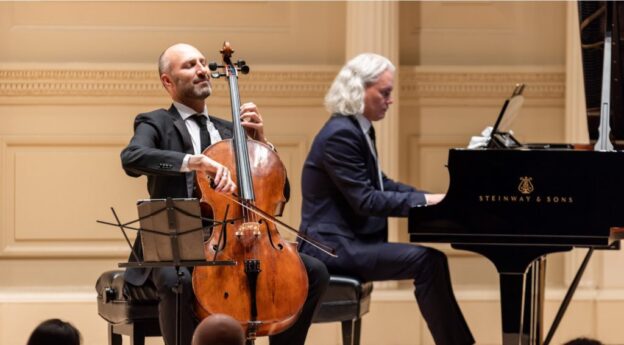 United States Various: Tobias van der Pals (cellist), Pål Eide (piano). Weill Recital Hall, Carnegie Hall, New York, 10.11.2022. (DS)
United States Various: Tobias van der Pals (cellist), Pål Eide (piano). Weill Recital Hall, Carnegie Hall, New York, 10.11.2022. (DS)

Glière – Con Moto in E Major from ‘Twelve Pieces’, Op.51 No.1
Glazunov – ‘Chant du menestrel’, Op.71
Leopold van der Pals – Sonata, Op.5a (world premiere)
Tchaikovsky – ‘Pezzo capriccioso’, Op.62
Rachmaninoff – Sonata in G minor, Op.19
As the days grew short in New York City and temperatures plummeted to freezing, the need was high for the comfort so singularly found in intimate recitals of salon-reminiscent music. Fortunately, Weill Recital Hall in Carnegie Hall is back in full swing with a roster of chamber music and solo offerings. And with performers returning from all corners of the globe, one can be wrapped in the pleasure of hearing repertoire beyond that of the local zeitgeist.
In early November, cellist Tobias van der Pals and pianist Pål Eide made the trip from Scandinavia to offer a captivating performance of newly re-discovered works as well as others rarely heard in concert on this side of the Atlantic. Even the pieces by composers popular in the United States – Tchaikovsky and Rachmaninoff – were gems chosen from unfairly neglected repertoire.
Van der Pals and Eide performed the two opening short pieces by Reinhold Glière and Alexander Galzunov with a welcoming tone and lightness of emotion that was perfectly reminiscent of the fin de siècle period. Van der Pals’s style is one of joyful strength and charming, casual comfort, and the response of the New York audience was ecstatic. The partnership with pianist Eide established a blend of unwavering mutual support without sacrificing independence and married their sound into a musical conversation that was appealing to hear.
They performed the recently unearthed Sonata in D minor by the cellist’s distant relative, Leopold van der Pals. Taking on the role of musical archeologist, van der Pals found the manuscript and re-worked it painstakingly into a performance-level piece. It was originally written in exile during World War II at a time when many composers became disconnected from colleagues and broader musical movements, and represented a frozen moment in time – like a lost letter folded into more broadly known historical events. Van der Pals performed the work with a passion that expressed a love of family, home, history and discovery. The sonata itself struck a wonderful tone between expressionist drama and hints of modernist structure – never abandoning completely familiar tonalities yet remaining hypnotically fresh.
The cellist’s approach to sound throughout the concert reflected a dynamic relationship to the character of music. Through his movements and pleasantly unfiltered facial expressions, he embodied the moods that passed throughout the works. Even during Tchaikovsky’s technically unforgiving ‘Pezzo capriccioso’, his smiles, sweeping gestures and unabashed changes in vibrato were matched to their purpose. His thoughtful knowledge and uncompromised love of the repertoire were enthralling. Beside him, Eide’s clear rhythmic playing and fluid approach to dynamics made for an ideal partner in the string sonata while showcasing the essential role of the piano in this repertoire. They created an improvisational-like ease that remained consistent throughout, even in the most difficult passages.
To conclude, they journeyed through Rachmaninoff’s 1901 Sonata for Cello and Piano with a wonderful combination of expressive urgency and laid-back curiosity. They embraced, head on, each contrast in Rachmaninoff’s mixture of the simple and the complex, from the motif to the intensely melodic. And they did not hesitate to boldly frame the unusual dips and climaxes of the final Allegro mosso movement with an effective decision to highlight the pauses that exist in Rachmaninoff’s composition, giving it a brilliant interpretation that avoided the usual (admittedly North American tendency) to play his works with syrupy, shallow nostalgia.
The recital successfully transported listeners from the present moment to the past and onward to the unknown, surprising us at every turn. Van der Pals and Eide received a standing ovation and, with an energy that showed no end in sight, performed their encores (a Glazunov Spanish Serenade and van der Pals’s Nach der Jagt) to a grateful and ebullient audience.
Daniele Sahr

A fantastic history! Good job dad!
How true this is! We can only agree in every word of it👏👏👏🎶❤️
How wonderful it was to sit in the audience!!
Thanks for this! I’m a big fan of Tobias van der Pals, amazing Cellist! And a wonderful hard-working duo!